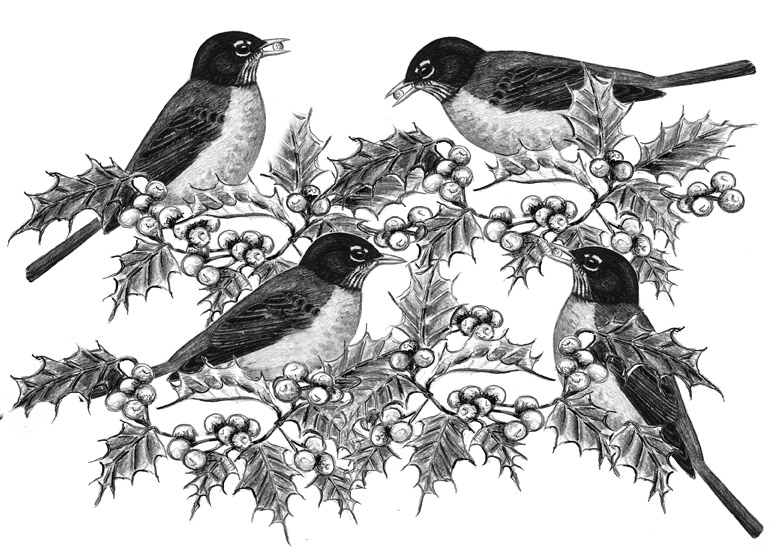
Dear Bird Folks,
After a fairly quiet winter, my feeders have suddenly become loaded with birds. In addition, we are getting huge flocks of robins. Where did they all come from and why did they seem to appear at once?
– Steven, Sandwich, MA
No kidding, Steven,
You don’t have to tell me that it’s been a quiet winter at bird feeders. Two winters ago, when the entire Northeast, including Cape Cod, was buried in a record-breaking eleventeen million inches of snow, our birdseed sales also broke records (and my back). This year has not been nearly as hectic. Even the storms in January didn’t help, as those storms mostly impacted us and not the rest of New England. Why do I care about the rest of New England? Well, I don’t usually, but often when the weather is nasty inland, many birds head to the relatively milder coast. However, last week’s storms really buried inland areas more…which is the way it should be.
Note: When I started this column we were digging out of our second snowstorm of the week. Since then, the weather has become downright balmy. Thus, much of what I’m writing may be irrelevant by the time you read it. So, blame the changing weather…and not fake news.
As much as we like to think birds depend on our feeders, in reality they would rather eat natural food. (If you find this information upsetting, think how I feel.) Fortunately, birds will quickly rediscover our feeders when their natural food is in short supply, or becomes buried under snow and ice. We are likely to see lots more chickadees, titmice, cardinals, etc. just before and right after a big storm. Robins, on the other hand, don’t typically feed in our yards in the winter. But after last week’s blizzard, my yard, your yard and the yards of many of my customers were unexpectedly filled with flocks of hungry robins. Was the arrival of so many robins a sign of an early spring? No, that’s the groundhog’s job. The robins we saw were merely birds that couldn’t gain access to their natural food. And what is their natural food in winter? I’ll give you a hint: it’s not worms.
The American Robin is one of North America’s most common and most adaptable birds. They are just as comfortable in a suburban backyard as in a distant forest. Each fall thousands and thousands of them leave their northern breeding grounds and head south. Many of my customers call these seasonal migrants “Canadian robins.” Some people even claim that they are fatter than the “regular” robins. (People can be so cruel.) While there is little doubt we get huge numbers of robins from Canada each winter (many of which aren’t vetted, by the way), they are not any fatter than the birds that build their nests in our yards each summer. Really. I’m not sure why folks think the winter robins are fatter, but the birds are sensitive about it and wish the hurtful stereotype would stop.
Even though our winters are milder than what the birds typically experience in Canada, we still don’t have “worm” weather. So, instead of worms, robins switch their diet to fruit. Chokeberries, mulberries and winterberries now take the place of worms and other such crawly things. Most of the time the birds find fruit in and around nearby wetlands, bogs and riparian areas, which is why we don’t see them in our yards. However, storms can alter the situation in a hurry. Last week’s storm started out as rain, then it changed to snow and ended up becoming a blizzard. The birds’ food was suddenly encased in ice and snow. This caused flocks of robins to abandon the woods and look for alternative food sources. The morning after the storm, waves of robins engulfed the juniper trees in my neighborhood. As they fed on the snow-covered branches, the stately birds looked as if they were posing for Christmas cards. The next stop, after their berry binge, was my birdbath. But there was no bathing. The birds needed water to wash down the berries and to help them spit up and poop out the berry pits. (This was not a Christmas card moment.) The scene lasted for two days, then the sun came out, the snow and ice melted, and the robins went back to the bogs…and I spent an hour scrubbing out my birdbath.
Here’s another robin mystery that folks ask me about. Why are the berries of certain trees ignored, while others are totally devoured? It seems robins are fairly fussy about what they eat, which is surprising for such fat birds. Studies have shown that darker and larger berries were typically taken first, eventually followed by orange and yellow fruit. The very last thing to be eaten was fruit cocktail, particularly when it’s floating in a Jell-O mold…and with good reason. What can we offer hungry robins? During the frigid winter of 2015, when just about every berry tree was stripped clean, I experimented with several food items including grapes, raisins and cranberries. I discovered that the robins in my yard regularly came for bits of chopped apple. Apparently, even robins know about that “apple a day…” thing.
The robins you saw after the storm, Steven, came from area wetlands, and will likely go back there now that the weather has improved. Eventually, however, those birds will leave here and make the long trek back to Canada, a trek that has suddenly become very popular.